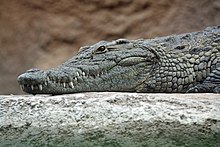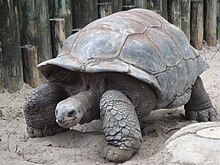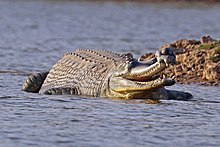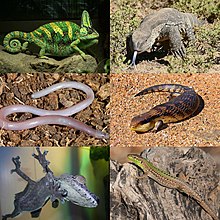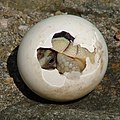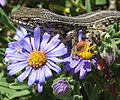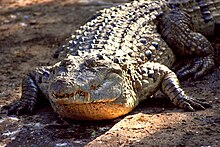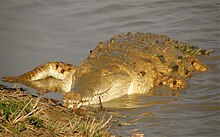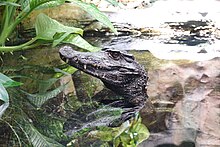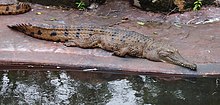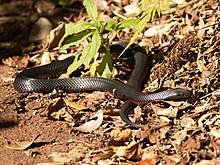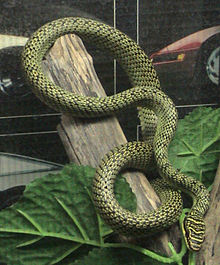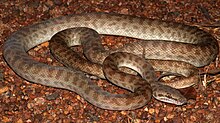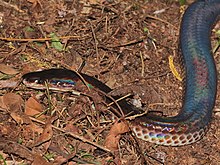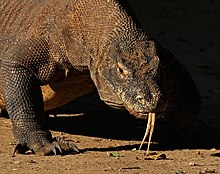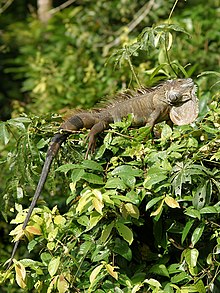Portal:Reptiles
Portal maintenance status: (June 2018)
|
The Reptiles Portal
Reptiles, as commonly defined, are a group of tetrapods with an ectothermic ('cold-blooded') metabolism and amniotic development. Living traditional reptiles comprise four orders: Testudines (turtles), Crocodilia (crocodilians), Squamata (lizards and snakes), and Rhynchocephalia (the tuatara). As of May 2023, about 12,000 living species of reptiles are listed in the Reptile Database. The study of the traditional reptile orders, customarily in combination with the study of modern amphibians, is called herpetology.
Reptiles have been subject to several conflicting taxonomic definitions. In Linnaean taxonomy, reptiles are gathered together under the class Reptilia (/rɛpˈtɪliə/ rep-TIL-ee-ə), which corresponds to common usage. Modern cladistic taxonomy regards that group as paraphyletic, since genetic and paleontological evidence has determined that birds (class Aves), as members of Dinosauria, are more closely related to living crocodilians than to other reptiles, and are thus nested among reptiles from an evolutionary perspective. Many cladistic systems therefore redefine Reptilia as a clade (monophyletic group) including birds, though the precise definition of this clade varies between authors. Others prioritize the clade Sauropsida, which typically refers to all amniotes more closely related to modern reptiles than to mammals.
The earliest known proto-reptiles originated from the Carboniferous period, having evolved from advanced reptiliomorph tetrapods which became increasingly adapted to life on dry land. The earliest known eureptile ("true reptile") was Hylonomus, a small and superficially lizard-like animal which lived in Nova Scotia during the Bashkirian age of the Late Carboniferous, around 318 million years ago. Genetic and fossil data argues that the two largest lineages of reptiles, Archosauromorpha (crocodilians, birds, and kin) and Lepidosauromorpha (lizards, and kin), diverged during the Permian period. In addition to the living reptiles, there are many diverse groups that are now extinct, in some cases due to mass extinction events. In particular, the Cretaceous–Paleogene extinction event wiped out the pterosaurs, plesiosaurs, and all non-avian dinosaurs alongside many species of crocodyliforms and squamates (e.g., mosasaurs). Modern non-bird reptiles inhabit all the continents except Antarctica. (Full article...)
Reptile types
-
Image 1Nile crocodile (Crocodylus niloticus)
Crocodiles (family Crocodylidae) or true crocodiles are large, semiaquatic reptiles that live throughout the tropics in Africa, Asia, the Americas and Australia. The term “crocodile” is sometimes used more loosely to include all extant members of the order Crocodilia, which includes the alligators and caimans (both members of the family Alligatoridae), the gharial and false gharial (both members of the family Gavialidae) as well as other, extinct, taxa. (Full article...) -
Image 2Aldabra giant tortoise
(Aldabrachelys gigantea)
Tortoises (/ˈtɔːrtəs.ɪz/ TOR-təs-iz) are reptiles of the family Testudinidae of the order Testudines (Latin for "tortoise"). Like other turtles, tortoises have a shell to protect from predation and other threats. The shell in tortoises is generally hard, and like other members of the suborder Cryptodira, they retract their necks and heads directly backward into the shell to protect them. (Full article...) -
Image 3Blanus cinereus, Spain
Amphisbaenia /æmfɪsˈbiːniə/ (called amphisbaenians or worm lizards) is a group of typically legless lizards, comprising over 200 extant species. Amphisbaenians are characterized by their long bodies, the reduction or loss of the limbs, and rudimentary eyes. As many species have a pink body and scales arranged in rings, they have a superficial resemblance to earthworms. While the genus Bipes retains forelimbs, all other genera are limbless. Phylogenetic studies suggest that they are nested within Lacertoidea, closely related to the lizard family Lacertidae. Amphisbaenians are widely distributed, occurring in North America, Europe, Africa, South America, Western Asia and the Caribbean. Most species are less than 6 inches (15 cm) long. (Full article...) -
Image 4
The gharial (Gavialis gangeticus), also known as gavial or fish-eating crocodile, is a crocodilian in the family Gavialidae and among the longest of all living crocodilians. Mature females are 2.6 to 4.5 m (8 ft 6 in to 14 ft 9 in) long, and males 3 to 6 m (9 ft 10 in to 19 ft 8 in). Adult males have a distinct boss at the end of the snout, which resembles an earthenware pot known as a ghara, hence the name "gharial". The gharial is well adapted to catching fish because of its long, narrow snout and 110 sharp, interlocking teeth. (Full article...) -
Image 5
Snakes are elongated, limbless reptiles of the suborder Serpentes (/sɜːrˈpɛntiːz/). Like all other squamates, snakes are ectothermic, amniote vertebrates covered in overlapping scales. Many species of snakes have skulls with several more joints than their lizard ancestors, enabling them to swallow prey much larger than their heads (cranial kinesis). To accommodate their narrow bodies, snakes' paired organs (such as kidneys) appear one in front of the other instead of side by side, and most have only one functional lung. Some species retain a pelvic girdle with a pair of vestigial claws on either side of the cloaca. Lizards have independently evolved elongate bodies without limbs or with greatly reduced limbs at least twenty-five times via convergent evolution, leading to many lineages of legless lizards. These resemble snakes, but several common groups of legless lizards have eyelids and external ears, which snakes lack, although this rule is not universal (see Amphisbaenia, Dibamidae, and Pygopodidae). (Full article...) -
Image 6
Turtles are reptiles of the order Testudines, characterized by a special shell developed mainly from their ribs. Modern turtles are divided into two major groups, the Pleurodira (side necked turtles) and Cryptodira (hidden necked turtles), which differ in the way the head retracts. There are 360 living and recently extinct species of turtles, including land-dwelling tortoises and freshwater terrapins. They are found on most continents, some islands and, in the case of sea turtles, much of the ocean. Like other amniotes (reptiles, birds, and mammals) they breathe air and do not lay eggs underwater, although many species live in or around water. (Full article...) -
Image 7Yacare caiman, Caiman yacare
A caiman (/ˈkeɪmən/ (also spelled cayman) from Taíno kaiman[additional citation(s) needed]) is an alligatorid belonging to the subfamily Caimaninae, one of two primary lineages within the Alligatoridae family, the other being alligators. Caimans are native to Central and South America and inhabit marshes, swamps, lakes, and mangrove rivers. They have scaly skin and live a fairly nocturnal existence. They are relatively small-sized crocodilians with an average maximum weight of 6 to 40 kg (13 to 88 lb) depending on species, with the exception of the black caiman (Melanosuchus niger), which can grow more than 4 m (13 ft) in length and weigh in excess of 450 kg (1,000 Ib). The black caiman is the largest caiman species in the world and is found in the slow-moving rivers and lakes that surround the Amazon basin. The smallest species is the Cuvier's dwarf caiman (Paleosuchus palpebrosus), which grows to 1.2 to 1.5 m (3.9 to 4.9 ft) long. There are six different species of caiman found throughout the watery jungle habitats of Central and Southern America. The average length for most of the other caiman species is about 2 to 2.5 m (6.6 to 8.2 ft) long. (Full article...) -
Image 8Clockwise from top left: veiled chameleon (Chamaeleo calyptratus), rock monitor (Varanus albigularis), common blue-tongued skink (Tiliqua scincoides), Italian wall lizard (Podarcis sicula), giant leaf-tailed gecko (Uroplatus fimbriatus), and legless lizard (Anelytropsis papillosus)
Lizard is the common name used for all squamate reptiles other than snakes (and to a lesser extent amphisbaenians), encompassing over 7,000 species, ranging across all continents except Antarctica, as well as most oceanic island chains. The grouping is paraphyletic as some lizards are more closely related to snakes than they are to other lizards. Lizards range in size from chameleons and geckos a few centimeters long to the 3-meter-long Komodo dragon. (Full article...) -
Image 9
The tuatara (Sphenodon punctatus) is a species of reptile endemic to New Zealand. Despite its close resemblance to lizards, it is part of a distinct lineage, the order Rhynchocephalia. The name tuatara is derived from the Māori language and means "peaks on the back". (Full article...) -
Image 10An American alligator (top) and a Chinese alligator
An alligator, or colloquially gator, is a large reptile in the genus Alligator of the family Alligatoridae of the order Crocodilia. The two extant species are the American alligator (A. mississippiensis) and the Chinese alligator (A. sinensis). Additionally, several extinct species of alligator are known from fossil remains. Alligators first appeared during the late Eocene epoch about 37 million years ago. (Full article...)
Selected images
-
Image 1Photo credit: Mila ZinkovaThe green turtle (Chelonia mydas) is a large sea turtle belonging to the family Cheloniidae. Despite the turtle's common name, it is lightly-colored all around while its carapace's hues range from olive-brown to black. The turtle is actually named for the greenish coloration of its fat and flesh.
-
Image 2Photo credit: Rich TorresChamaeleo jacksonii, commonly known as Jackson's Chameleon or the Three-horned Chameleon, is an African chameleon. Native to the humid, cooler regions of Kenya and Tanzania, this specimen is from a feral population established in Hawaii in the 1970s. Males possess three brown horns, but females usually have none or just traces of the rostral horn (on the nose).
-
Image 3Photo credit: LiquidGhoulThe head of a Coastal Carpet Python, the largest subspecies of Morelia spilota, a non-venomous Australian python, showing its forked tongue, a feature common to many reptiles, who smell using the tip of their tongue. Having a forked tongue allows them to tell which direction a smell is coming from.
-
Image 4Asian vine snake Ahaetulla prasina. This snake has a wide distribution in Asia. It feeds on small reptiles and amphibians, particularly lizards and tree frogs. Adults may attain 1.8 m (6 feet) in total length, with a tail 0.6 m (2 feet) long. Its appearance is very much like those of South American vine snakes. It is a rear-fanged species and is mildly venomous but is not considered a threat to humans.
-
Image 5Photograph: Steve JurvetsonThe western terrestrial garter snake (Thamnophis elegans) is a species of colubrid snake found in southwestern Canada and the western United States. It is the only species of garter snake with a well-documented tendency to constrict prey.
-
Image 6Photograph: Benny TrappVipera dinniki is a species of venomous viper which can reach 48.6 cm (19.1 in) in length. First described by Alexander Nikolsky in 1913, V. dinniki is found in the highlands of Russia, Georgia, and Azerbaijan.
-
Image 10Photograph: H. KrispPhelsuma grandis is a species of day gecko that lives in Madagascar. Found in a wide range of habitats, it can measure up to 30 centimetres (12 in) in length.
-
Image 11A baby marginated tortoise hatchling emerges from its shell.
-
Image 12Cerastes cerastes, commonly known as the Saharan horned viper or the horned desert viper, is a venomous species of viper native to the deserts of northern Africa and parts of the Arabian Peninsula and Levant. It often is easily recognized by the presence of a pair of supraocular "horns", although hornless individuals do occur.
-
Image 13Photograph: Charles J. SharpA rough chameleon (Trioceros rudis) near Mount Karisimbi, an inactive volcano in the Virunga Mountains in Rwanda. This specimen measures approximately 12 cm (4.7 in) long. Chameleons change color by changing the space between crystals in their skin, which changes the wavelength of light they reflect.
-
Image 15Leiocephalus personatus is a species of curly-tailed lizard first described by Edward Drinker Cope in 1862. This specimen was photographed in the reptile zoo of Neu-Ulm, Germany.
-
Image 16Image credit: ArthurWeasleyDiagram showing the appearances and relative sizes of 18 basal species of Ceratopsians (frilled, beaked dinosaurs typified by Triceratops). Animals are shown in order of geologic stage from left to right and top to bottom, with species names and stage information as annotation.
Ceratopsians were beaked herbivores who lived in what are now North America and Asia, during the Cretaceous Period. Early members such as Psittacosaurus were small and bipedal. Later members, including ceratopsids like Centrosaurus and Triceratops, became very large quadrupeds and developed elaborate facial horns and a neck frill. -
Image 17Photograph: Yathin S KrishnappaThe Namaqua chameleon (Chamaeleo namaquensis) is a lizard found in the western desert regions of Namibia, South Africa, and southern Angola. This species, which can reach 25 cm (9.8 in) in length, is common in the Namib Desert. It has evolved several adaptations which allow it to thrive in hot and arid areas, such as the ability to change color to control temperature.
-
Image 18Photo credit: Mila ZinkovaA Gold dust day gecko (Phelsuma laticauda laticauda) licking nectar from a bird of paradise flower in Kailua-Kona, Hawaii. Native to Madagascar and the Comoro Islands, this day gecko has been introduced to Farquhar Atoll in the southern Seychelles, and onto the Hawaiian Islands.
-
Image 19The Italian wall lizard (Podarcis sicula) is native to southern and southeastern Europe. As the name suggests, it is the most abundant lizard species in southern Italy. The species is known for having been subject to "rapid evolution": In 1971, ten adult specimens were brought to the Croatian island of Pod Mrčaru from a neighbouring island, where they founded a new bottlenecked population. After the Yugoslav Wars, scientists found that the Pod Mrčaru population differed greatly from the original group, although the two are genetically identical. The most surprising difference was that individuals on Pod Mrčaru had developed cecal valves, "a brand new feature not present in the ancestral population".
-
Image 20Photo: Ester InbarThe Sinai Agama (Pseudotrapelus sinaitus) is an agamid lizard native to northern and eastern Africa and the Middle East. It grows to about 25 cm (10 in) long, with the tail accounting for up to two thirds of the total length. It is active during daytime and feeds on insects and other arthropods and plants. During the breeding season, males become a striking blue colour to attract females.
-
Image 21Photo credit: Paul HirstAn anole lizard of the family Polychrotidae found in Hilo, Hawaii, United States. Anoles are small and common lizards that can be found throughout the various regions of the Western Hemisphere. They are frequently and incorrectly called chameleons or geckos due to their ability to alter their skin color and run up walls, respectively.
-
Image 22Photo credit: Marcel Burkhard (cele4)The Plumed Basilisk (Basiliscus plumifrons) is a species of lizard native to Latin America. Its natural range covers a swath from Mexico to Ecuador.
-
Image 23Cape skink – Trachylepis capensis. Close-up on purple Aster flowers.
-
Image 24Photograph credit: Basile MorinEutropis macularia, the bronze grass skink, is a species of lizard in the skink family, Scincidae, native to South and Southeast Asia. It lives in both deciduous and evergreen forests, in plantations, in grasslands, and in rocky areas with scattered trees. The species is active in both the day and the night, feeding on insects and other invertebrates. This bronze grass skink was photographed on a tree trunk on the island of Don Det in Laos.
-
Image 25Photograph: Geoff GalliceBothriechis schlegelii is a venomous pit viper species found in Central and South America. Small and arboreal, these snakes are characterized by their wide array of color variations, as well as the superciliary scales over the eyes. They are the most common of the palm-pitvipers and are often present in zoological exhibits. The specific name schlegelii honors the German ornithologist, Hermann Schlegel. No subspecies are currently recognized.
Selected Crocodilia articles
-
Image 1At Zapata Swamp, Matanzas Province, Cuba
The Cuban crocodile (Crocodylus rhombifer) is a small-medium species of crocodile endemic to Cuba. Typical length is 2.1–2.3 m (6.9–7.5 ft) and typical weight 70–80 kg (150–180 lb). Large males can reach as much as 3.5 m (11 ft) in length and weigh more than 215 kg (474 lb). Despite its smaller size, it is a highly aggressive animal (one of the most territorial of all crocodilians), and potentially dangerous to humans.
The Cuban crocodile is of interest to biologists for its unique physical and behavioral traits. Long- and strong-legged, it is the most terrestrial of extant crocodiles. Its preferred habitat comprises freshwater and brackish water environments, such as mangrove swamps, coastal lagoons, estuaries, marshes, floodplains, and river deltas. There, the adults feed on fish, turtles and small mammals, while the young eat invertebrates and smaller fish. Mating occurs between May and July. Captive animals have displayed cooperative hunting behavior, and can be taught tricks, suggesting intelligence. (Full article...) -
Image 2At the Columbus Zoo and Aquarium in Powell, Ohio
The American alligator (Alligator mississippiensis), sometimes referred to as a gator, or common alligator is a large crocodilian reptile native to the Southeastern United States and a small section of northeastern Mexico. It is one of the two extant species in the genus Alligator, and is larger than the only other living alligator species, the Chinese alligator.
Adult male American alligators measure 3.4 to 4.6 m (11.2 to 15.1 ft) in length, and can weigh up to 500 kg (1,100 lb), with unverified sizes of up to 5.84 m (19.2 ft) and weights of 1,000 kg (2,200 lb) making it the second largest member by length and the heaviest of the family Alligatoridae, after the black caiman. Females are smaller, measuring 2.6 to 3 m (8.5 to 9.8 ft) in length. The American alligator inhabits subtropical and tropical freshwater wetlands, such as marshes and cypress swamps, from southern Texas to North Carolina. It is distinguished from the sympatric American crocodile by its broader snout, with overlapping jaws and darker coloration, and is less tolerant of saltwater but more tolerant of cooler climates than the American crocodile, which is found only in tropical and warm subtropical climates. (Full article...) -
Image 3
The spectacled caiman (Caiman crocodilus), also known as the white caiman, common caiman, and speckled caiman, is a crocodilian in the family Alligatoridae. It is brownish-, greenish-, or yellowish-gray colored and has a spectacle-like ridge between its eyes, which is where its common name come from. It grows to a length of 1.4–2.5 m (4 ft 7 in – 8 ft 2 in) and a weight of 7–40 kg (15–88 lb), with males being both longer and heavier than females. Its diet varies seasonally, commonly consisting of crabs, fish, small mammals, amphibians and snails. Breeding occurs from May to August and 14–40 eggs are laid in July and August. This crocodilian has a large range and population; it is native to much of Latin America, and has been introduced to the United States, Cuba, and Puerto Rico. (Full article...) -
Image 4

The black caiman (Melanosuchus niger) is a crocodilian reptile endemic to South America. With a maximum length of around 5 to 6 m (16 to 20 ft) and a mass of over 450 kg (1,000 lb), it is the largest living species of the family Alligatoridae, and the third-largest crocodilian in the Neotropical realm. True to its common and scientific names, the black caiman has a dark greenish-black coloration as an adult. In some individuals, the pigmentation can appear almost jet-black. It has grey to brown banding on the lower jaw; juveniles have a more vibrant coloration compared to adults, with prominent white-pale yellow banding on the flanks that remains present well into adulthood (more than most other species). The banding on young animals helps with camouflage by breaking up their body outline, on land or in water, in an effort to avoid predation. The morphology is quite different from other caimans but the bony ridge that occurs in other caimans is present. The head is large and heavy, an advantage in catching larger prey. Like all crocodilians, caimans are long, squat creatures, with big jaws, long tails and short legs. They have thick, scaled skin, and their eyes and noses are located on the tops of their heads. This enables them to see and breathe while the rest of their bodies are underwater.
A carnivorous animal, the black caiman lives along freshwater habitats, including slow-moving rivers, lakes and seasonally flooded savannas, where it preys upon a variety of fish, reptiles, birds, and mammals. Being an apex predator and potentially a keystone species, it is generalist, capable of taking most animals within its range, and might have played a critical role in maintaining structure of the ecosystem. Although merely few specific ecological studies have been conducted, it is observed that this species has its own niche which allows coexistence with other competitors. (Full article...) -
Image 5
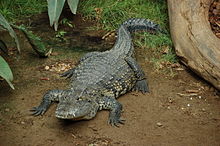
Morelet's crocodile (Crocodylus moreletii), also known as the Mexican crocodile or Belize crocodile, is a modest-sized crocodilian found only in the Atlantic regions of Mexico, Belize and Guatemala. It usually grows to about 3 metres (10 ft) in length. It is a species at least concern for extinction according to the International Union for Conservation of Nature.
The species has a fossil record in Guatemala. (Full article...) -
Image 6An adult basking on the island of Palawan, Philippines
The Philippine crocodile (Crocodylus mindorensis), also known as the Mindoro crocodile, the Philippine freshwater crocodile, the bukarot in Ilocano, and more generally as a buwaya in most Filipino lowland cultures, is one of two species of crocodiles found in the Philippines; the other is the larger saltwater crocodile (Crocodylus porosus). The Philippine crocodile, the species endemic only to the country, went from data deficient to critically endangered in 2008 from exploitation and unsustainable fishing methods, such as dynamite fishing. Conservation methods are being taken by the Dutch/Filipino Mabuwaya foundation, the Crocodile Conservation Society and the Zoological Institute of HerpaWorld in Mindoro island. It is strictly prohibited to kill a crocodile in the country, and it is punishable by law. (Full article...) -
Image 7Mato Grosso, Brazil
The yacare caiman (Caiman yacare), also known commonly as the jacare caiman, Paraguayan caiman, piranha caiman, red caiman, and southern spectacled caiman, is a species of caiman, a crocodilian in the family Alligatoridae. The species is endemic to Argentina, Bolivia, Brazil, and Paraguay. Brown in color and covered with dark blotches, males grow to a total length (including tail) of 2–3 m (6 ft 7 in – 9 ft 10 in) and weigh around 40–50 kg (88–110 lb); while females grow to 1.4 m (4 ft 7 in) long and about 15–20 kg (33–44 lb). Typical habitats of this caiman include lakes, rivers, and wetlands. Its diet primarily consists of aquatic animals, such as snails, and occasionally land vertebrates. Mating occurs in the rainy season and eggs hatch in March, with young fending for themselves as soon as they hatch. The yacare caiman was hunted heavily for its skin to use for leather in the 1980s, which caused its population to decrease significantly. However, trading restrictions placed since have caused its population to increase. Its population in the Pantanal is about 10 million, and it is listed as least concern on the IUCN Red List. (Full article...) -
Image 8
Mecistops is a genus of crocodiles, the slender-snouted crocodiles, native to sub-Saharan Africa. (Full article...) -
Image 9At Le Bonheur Crocodile Farm near Stellenbosch, South Africa
The Nile crocodile (Crocodylus niloticus) is a large crocodilian native to freshwater habitats in Africa, where it is present in 26 countries. It is widely distributed in sub-Saharan Africa, occurring mostly in the eastern, southern, and central regions of the continent, and lives in different types of aquatic environments such as lakes, rivers, swamps and marshlands. It occasionally inhabits deltas, brackish lakes and rarely also saltwater. Its range once stretched from the Nile Delta throughout the Nile River. Lake Turkana in Kenya has one of the largest undisturbed Nile crocodile populations.
Generally, the adult male Nile crocodile is between 3.5 and 5 m (11 ft 6 in and 16 ft 5 in) in length and weighs 225 to 750 kg (496 to 1,653 lb). However, specimens exceeding 6.1 m (20 ft) in length and 1,000 kg (2,200 lb) in weight have been recorded. It is the largest predator in Africa, and may be considered the second-largest extant reptile in the world, after the saltwater crocodile (Crocodylus porosus). Size is sexually dimorphic, with females usually about 30% smaller than males. The crocodile has thick, scaly, heavily armoured skin. (Full article...) -
Image 10

The Chinese alligator (Alligator sinensis; simplified Chinese: 鼍; traditional Chinese: 鼉; pinyin: tuó), also known as the Yangtze alligator (simplified Chinese: 扬子鳄; traditional Chinese: 揚子鱷; pinyin: yángzǐ'è), China alligator, or historically the muddy dragon, is a crocodilian endemic to China. It and the American alligator (A. mississippiensis) are the only living species in the genus Alligator of the family Alligatoridae. Dark gray or black in color with a fully armored body, the Chinese alligator grows to 1.5–2.1 metres (5–7 ft) in length and weighs 36–45 kilograms (80–100 lb) as an adult. It brumates in burrows in winter and is nocturnal in summer. Mating occurs in early summer, with females most commonly producing 20–30 eggs, which are smaller than those of any other crocodilian. The species is an opportunistic feeder, primarily eating fish and invertebrates. A vocal species, adults bellow during the mating season and young vocalize to communicate with their parents and other juveniles. Captive specimens have reached age 70, and wild specimens can live past 50.
Living in bodies of fresh water, the Chinese alligator's range is restricted to six regions in the province of Anhui, as well as possibly the provinces of Jiangsu and Zhejiang. Originally living as far away from its current range as Japan, the species previously had a wide range and population, but beginning in 6000 BC, multiple threats, such as habitat destruction, caused the species' population and range to decline. The population in the wild was about 1,000 in the 1970s, decreased to below 130 in 2001, and grew after 2003, with its population being about 300 as of 2017. Listed as critically endangered by the International Union for Conservation of Nature, multiple conservation actions have been taking place for this species. (Full article...) -
Image 11
The gharial (Gavialis gangeticus), also known as gavial or fish-eating crocodile, is a crocodilian in the family Gavialidae and among the longest of all living crocodilians. Mature females are 2.6 to 4.5 m (8 ft 6 in to 14 ft 9 in) long, and males 3 to 6 m (9 ft 10 in to 19 ft 8 in). Adult males have a distinct boss at the end of the snout, which resembles an earthenware pot known as a ghara, hence the name "gharial". The gharial is well adapted to catching fish because of its long, narrow snout and 110 sharp, interlocking teeth.
The gharial probably evolved in the northern Indian subcontinent. Fossil gharial remains were excavated in Pliocene deposits in the Sivalik Hills and the Narmada River valley. It currently inhabits rivers in the plains of the northern part of the Indian subcontinent. It is the most thoroughly aquatic crocodilian, and leaves the water only for basking and building nests on moist sandbanks. Adults mate at the end of the cold season. Females congregate in spring to dig nests, in which they lay 20–95 eggs. They guard the nests and the young, which hatch before the onset of the monsoon. The hatchlings stay and forage in shallow water during their first year, but move to sites with deeper water as they grow. (Full article...) -
Image 12
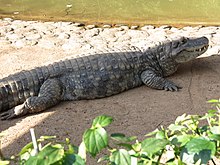
The broad-snouted caiman (Caiman latirostris) is a crocodilian in the family Alligatoridae found in eastern and central South America, including the Pantanal habitat of Bolivia, Southeast Brazil, and Paraguay, as well as northern Argentina and Uruguay. Behind the black caiman (Melanosuchus niger), it is the second-largest caiman species; it is the third-largest alligatorid behind the American alligator (Alligator mississippiensis) and the aforementioned black caiman. Primarily, the species inhabits freshwater wetlands, including floodplains, marshes, swamps, and some mangrove forests, as well as various streams, rivers, lakes or ponds, preferring bodies of rather still or slower-moving water. They will often utilize man-made cow ponds, disused stock tanks, and canals and ditches, as well. (Full article...) -
Image 13At La Manzanilla, Jalisco, Mexico
The American crocodile (Crocodylus acutus) is a species of crocodilian found in the Neotropics. It is the most widespread of the four extant species of crocodiles from the Americas, with populations present from South Florida, the Caribbean islands of Cuba, Jamaica, Hispaniola, and the coasts of Mexico to as far south as Peru, Ecuador, Colombia, and Venezuela.
The habitat of the American crocodile consists largely of coastal areas. It is also found in river systems, but tends to prefer salinity, resulting in the species congregating in brackish lakes, mangrove swamps, lagoons, cays, and small islands. Other crocodiles also have tolerance to saltwater due to salt glands underneath the tongue, but the American crocodile is the only species other than the saltwater crocodile to commonly live and thrive in saltwater. They can be found on beaches and small island formations without any freshwater source, such as many cays and islets across the Caribbean. They are also found in hypersaline lakes; one of the largest known populations inhabits Lago Enriquillo in the Dominican Republic. (Full article...) -
Image 14

The mugger crocodile (Crocodylus palustris) is a medium-sized broad-snouted crocodile, also known as mugger and marsh crocodile. It is native to freshwater habitats from southern Iran to the Indian subcontinent, where it inhabits marshes, lakes, rivers and artificial ponds. It rarely reaches a body length of 5 m (16 ft 5 in) and is a powerful swimmer, but also walks on land in search of suitable waterbodies during the hot season. Both young and adult mugger crocodiles dig burrows to which they retreat when the ambient temperature drops below 5 °C (41 °F) or exceeds 38 °C (100 °F). Females dig holes in the sand as nesting sites and lay up to 46 eggs during the dry season. The sex of hatchlings depends on temperature during incubation. Both parents protect the young for up to one year. They feed on insects, and adults prey on fish, reptiles, birds and mammals.
The mugger crocodile evolved at least 4.19 million years ago and has been a symbol for the fructifying and destructive powers of the rivers since the Vedic period. It was first scientifically described in 1831 and is protected by law in Iran, India and Sri Lanka. Since 1982, it has been listed as Vulnerable on the IUCN Red List. Outside protected areas, it is threatened by conversion of natural habitats, gets entangled in fishing nets and is killed in human–wildlife conflict situations and in traffic accidents. (Full article...) -
Image 15New Guinea crocodile at Bandung Zoo in West Java, Indonesia
The New Guinea crocodile (Crocodylus novaeguineae) is a small species of crocodile found on the island of New Guinea north of the mountain ridge that runs along the centre of the island. The population found south of the mountain ridge, formerly considered a genetically distinct population, is now considered a distinct species, Hall's New Guinea crocodile (C. halli). In the past it included the Philippine crocodile, C. n. mindorensis, as a subspecies, but today they are regarded as separate species. The habitat of the New Guinea crocodile is mostly freshwater swamps and lakes. It is most active at night when it feeds on fish and a range of other small animals. A female crocodile lays a clutch of eggs in a nest composed of vegetation and she lies up nearby to guard the nest. There is some degree of parental care for newly hatched juveniles. This crocodile was over-hunted for its valuable skin in the mid 20th century, but conservation measures have since been put in place, it is reared in ranches and the International Union for Conservation of Nature (IUCN) lists it as being of "Least Concern". (Full article...) -
Image 16
The Orinoco crocodile (Crocodylus intermedius) is a critically endangered crocodile. Its population is very small, and they can only be found in the Orinoco river basin in Venezuela and Colombia. Extensively hunted for their skins in the 19th and 20th centuries, it is one of the most endangered species of crocodiles. It is a very large species of crocodilian; males have been reported up to 6.8 m (22 ft 4 in) in the past, weighing over 900 kg (2,000 lb), but such sizes do not exist today, 5.2 m (17 ft 1 in) being a more widely accepted maximum size. A large male today may attain 4.2 m (13 ft 9 in) in length and can weigh up to 450 kg (1,000 lb), while females are substantially smaller with the largest likely to weigh around 225 kg (496 lb). Sexual dimorphism is not as profound as in other crocodilian species. The coloration is light even in adults.
The ecology of the Orinoco crocodile is poorly documented in the wild, mostly due to its small population. It is thought to have a more piscivorous diet with an opportunistic nature, resulting in generalist predatory behaviour. It is an apex predator and preys on a variety of birds, mammals and reptiles, including caimans on occasion. Its prey base is mostly large predatory fish, challenging the general view by locals complaining about crocodiles hunting local fish to very low numbers. Reproduction takes place in the dry season when the water level is low. It is a hole nester and digs holes in the sand for its clutch of eggs. The females guard the nests and young for several years. (Full article...) -
Image 17Specimen in Bazoulé, Burkina Faso
The West African crocodile, desert crocodile, or sacred crocodile (Crocodylus suchus) is a species of crocodile related to, and often confused with, the larger and more aggressive Nile crocodile (C. niloticus). (Full article...) -
Image 18A smooth-fronted caiman at Zoologischer Garten Berlin in Berlin, Germany
The smooth-fronted caiman (Paleosuchus trigonatus), also known as Schneider's dwarf caiman or Schneider's smooth-fronted caiman, is a crocodilian from South America, where it is native to the Amazon and Orinoco Basins. It is the second-smallest species of the family Alligatoridae, the smallest being Cuvier's dwarf caiman, also from tropical South America and in the same genus. An adult typically grows to around 1.2 to 1.6 m (3.9 to 5.2 ft) in length and weighs between 9 and 20 kg (20 and 44 lb). Exceptionally large males can reach as much as 2.3 m (7.5 ft) in length and 36 kg (79 lb) in weight. (Full article...) -
Image 19
The freshwater crocodile (Crocodylus johnstoni), also known commonly as the Australian freshwater crocodile, Johnstone's crocodile, and the freshie, is a species of crocodile native to the northern regions of Australia. Unlike its much larger Australian relative, the saltwater crocodile, the freshwater crocodile is not known as a man-eater, although it bites in self-defence, and brief, nonfatal attacks have occurred, apparently the result of mistaken identity. (Full article...) -
Image 20
The dwarf crocodile (Osteolaemus tetraspis), also known as the African dwarf crocodile, broad-snouted crocodile (a name more often used for the Asian mugger crocodile) or bony crocodile, is an African crocodile that is also the smallest extant (living) species of crocodile. (Full article...) -
Image 21
The Siamese crocodile (Crocodylus siamensis) is a medium-sized freshwater crocodile native to Indonesia (Borneo and possibly Java), Brunei, East Malaysia, Laos, Cambodia, Myanmar, Thailand and Vietnam. The species is critically endangered and already extirpated from many regions. Its other common names include Siamese freshwater crocodile, Singapore small-grain, and soft-belly. (Full article...) -
Image 22
The saltwater crocodile (Crocodylus porosus) is a crocodilian native to saltwater habitats, brackish wetlands and freshwater rivers from India's east coast across Southeast Asia and the Sundaland to northern Australia and Micronesia. It has been listed as Least Concern on the IUCN Red List since 1996. It was hunted for its skin throughout its range up to the 1970s, and is threatened by illegal killing and habitat loss. It is regarded as dangerous to humans.
The saltwater crocodile is the largest living reptile. Males can grow up to a weight of 1,000–1,500 kg (2,200–3,300 lb) and a length of 6 m (20 ft), rarely exceeding 6.3 m (21 ft). Females are much smaller and rarely surpass 3 m (9.8 ft). It is also called the estuarine crocodile, Indo-Pacific crocodile, marine crocodile, sea crocodile, and, informally, the saltie. A large and opportunistic hypercarnivorous apex predator, they ambush most of their prey and then drown or swallow it whole. They will prey on almost any animal that enters their territory, including other predators such as sharks, varieties of freshwater and saltwater fish including pelagic species, invertebrates such as crustaceans, various amphibians, other reptiles, birds, and mammals. (Full article...) -
Image 23
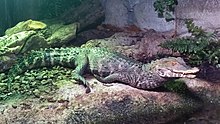
Cuvier's dwarf caiman (Paleosuchus palpebrosus) is a small crocodilian in the alligator family from northern and central South America. It is found in Bolivia, Brazil, Colombia, Ecuador, French Guiana, Guyana, Paraguay, Peru, Suriname, Trinidad and Venezuela. It lives in riverine forests, flooded forests near lakes, and near fast-flowing rivers and streams. It can traverse dry land to reach temporary pools and tolerates colder water than other species of caimans. Other common names for this species include the musky caiman, the dwarf caiman, Cuvier's caiman, and the smooth-fronted caiman (the latter name is also used for P. trigonatus). It is sometimes kept in captivity as a pet and may be referred to as the wedge-head caiman by the pet trade community.
Cuvier's dwarf caiman was first described by the French zoologist Georges Cuvier in 1807 and is one of only two species in the genus Paleosuchus, the other species being P. trigonatus. Their closest relatives are the other caimans in the subfamily Caimaninae. With a total length averaging 1.4 m (4.6 ft) for males and up to 1.2 m (3.9 ft) for females, Cuvier's dwarf caiman is not only the smallest extant species in the alligator and caiman family, but also the smallest of all crocodilians (unless the Congo dwarf crocodile is considered a valid species). An adult weighs around 5 to 7 kg (11 to 15 lb). Its lack of size is partly made up for by its strong body armor, provided by the bony bases to its dermal scales, which provides protection against predators. Juvenile dwarf caimans mainly feed on invertebrates, but also small fish and frogs, while adults eat larger fish, amphibians, and invertebrates, such as large molluscs. This caiman sometimes uses a burrow as shelter during the day and in the Pantanal may aestivate in the burrow to stay cool in the dry season. The female buries her eggs on a mounded nest and these take about 3 months to hatch. She helps the hatchlings to escape from the nest and provides some parental care for the first few weeks of their lives. This caiman has a wide range and large total population and the IUCN lists its conservation status as being of least concern. (Full article...)
Selected snake articles
-
Image 1A red-bellied black snake in Lamington National Park, Queensland
The red-bellied black snake (Pseudechis porphyriacus) is a species of venomous snake in the family Elapidae, indigenous to Australia. Originally described by George Shaw in 1794 as a species new to science, it is one of eastern Australia's most commonly encountered snakes. Averaging around 1.25 m (4 ft 1 in) in length, it has glossy black upperparts, bright red or orange flanks, and a pink or dull red belly. It is not aggressive and generally retreats from human encounters, but will defend itself if provoked. Although its venom can cause significant illness, no deaths have been recorded from its bite, which is less venomous than other Australian elapid snakes. The venom contains neurotoxins, myotoxins, and coagulants and has haemolytic properties. Victims can also lose their sense of smell. (Full article...) -
Image 2Ornate flying snake, Chrysopelea ornata
Chrysopelea, commonly known as the flying snake or gliding snake, is a genus of snakes that belongs to the family Colubridae. They are found in Southeast Asia, and are known for their ability to glide between trees. Flying snakes are mildly venomous, though the venom is dangerous only to their small prey. There are five species within the genus. (Full article...) -
Image 3

The dwarf beaked snake (Dipsina multimaculata), also called the western beaked snake, is a species of snake, which is endemic to southern Africa. It is in the monotypic genus Dipsina. (Full article...) -
Image 4The white-lipped keelback (Hebius leucomystax) is a species of nonvenomous natricine snake found in central Vietnam, Cambodia, and Laos. (Full article...)
-
Image 5Keelback may refer to any of the following snake genera:
- Amphiesma
- Amphiesmoides, a monotypic genus in the Colubridae with its sole representative, the white-eyed keelback, Amphiesmoides ornaticeps
- Atretium, a monotypic genus in the Colubridae with its sole representative, the split keelback, Atretium schistosum
- Fowlea
- Hebius
- Rhabdophis
- Helicops
- Herpetoreas
- Opisthotropis
- Pseudagkistrodon, a monotypic genus in the Colubridae with its sole representative, the red keelback, Pseudagkistrodon rudis
- Trimerodytes
- Tropidonophis
- Xenochrophis
-
Image 6
Boiga dendrophila, commonly called the mangrove snake or the gold-ringed cat snake, is a species of rear-fanged venomous snake in the family Colubridae. The species is endemic to southeast Asia. It is one of the biggest cat snake species, averaging 8–9 feet (2.4–2.7 m) in length. It is considered mildly venomous. Although moderate envenomations resulting in intense swelling have been reported, there has never been a confirmed fatality. (Full article...) -
Image 7
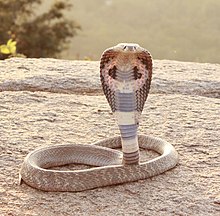
The Indian cobra (Naja naja /nadʒa nadʒa/), also known commonly as the spectacled cobra, Asian cobra, or binocellate cobra, is a species of cobra, a venomous snake in the family Elapidae. The species is native to the Indian subcontinent, and is a member of the "big four" species that are responsible for the most snakebite cases in India. (Full article...) -
Image 8
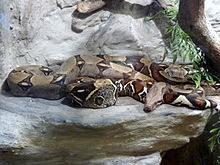
The boa constrictor (scientific name also Boa constrictor), also known as the common boa, is a species of large, non-venomous, heavy-bodied snake that is frequently kept and bred in captivity. The boa constrictor is a member of the family Boidae. The species is native to tropical South America. A staple of private collections and public displays, its color pattern is highly variable yet distinctive. Four subspecies are recognized. (Full article...) -
Image 9Wall's keelback (Herpetoreas xenura) is a species of natricine snake endemic to Northeast India. (Full article...)
-
Image 10
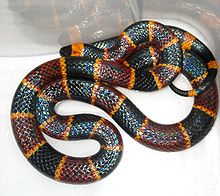
Micrurus fulvius, commonly known as the eastern coral snake, common coral snake, American cobra, and more, is a species of highly venomous coral snake in the family Elapidae. The family also contains the cobras and sea snakes. The species is endemic to the southeastern United States. It should not be confused with the scarlet snake (Cemophora coccinea) or scarlet kingsnake (Lampropeltis elapsoides), which are harmless mimics. No subspecies are currently recognized. (Full article...) -
Image 11

The tiger rattlesnake (Crotalus tigris) is a highly venomous pit viper species found in the southwestern United States and northwestern Mexico. No subspecies are currently recognized. The specific name tigris, (Latin for 'tiger'), refers to the many narrow dorsal crossbands, which create a pattern of vertical stripes when viewed from the side. (Full article...) -
Image 12

Coluber constrictor oaxaca, commonly known as the Mexican racer, is a nonvenomous colubrid snake, a subspecies of the eastern racer (Coluber constrictor). (Full article...) -
Image 13

The forest cobra (Naja melanoleuca), also commonly called the black cobra and the black and white-lipped cobra, is a species of
highly venomous snake in the family Elapidae. The species is native to Africa, mostly the central and western parts of the continent. It is the largest true cobra species with a record length of 3.2 metres (10 feet 6 inches). (Full article...) -
Image 14
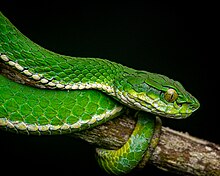
Craspedocephalus macrolepis, commonly known as the large-scaled pit viper, is a venomous pitviper species endemic to the Southern Western Ghats of South India. No subspecies are currently recognized. (Full article...) -
Image 15
Children's python (Antaresia childreni) is a species of nonvenomous snake in the family Pythonidae. The species is named after John George Children. It is a nocturnal species occurring in the northern half of Australia and generally found on the ground, although it often climbs trees. Usually growing to about 1.0 m (3 ft) in length or more depending on the polymorphic variant, it is typically a reddish-brown colour, darker on the upper surface, and with many darker blotches, especially on younger specimens. The Stimson's python variant has much stronger and more variable colours; often being adorned with reddish-brown to chocolate blotches against lighter tan. It feeds mostly on small mammals and birds, and as with other pythons, it constricts its prey before swallowing it whole. It is a popular pet among reptile enthusiasts. (Full article...) -
Image 16

Trimeresurus albolabris, the white-lipped pit viper or white-lipped tree viper, is a venomous pit viper species endemic to Southeast Asia. (Full article...) -
Image 17

The pygmy python (Antaresia perthensis), also known as the anthill python, is a species of snake found in Western Australia. Their common names are due to their being the smallest member of the family Pythonidae and often being found in termite mounds. No subspecies are currently recognised. (Full article...) -
Image 18Sunbeam snake (X. unicolor)
Xenopeltis, the sunbeam snakes, are the sole genus of the monotypic family Xenopeltidae, the species of which are found in Southeast Asia. Sunbeam snakes are known for their highly iridescent scales. Three species are recognized, each one with no subspecies. Studies of DNA suggest that the xenopeltids are most closely related to the Mexican burrowing python (Loxocemus bicolor) and to the true pythons (Pythonidae). (Full article...) -
Image 19
Thamnophis saurita, also known as the eastern ribbon snake, common ribbon snake, or simply ribbon snake, is a common species of garter snake native to Eastern North America. It is a non-venomous species of snake in the subfamily Natricinae of the family Colubridae. The ribbon snake averages 16 to 35 inches (41 to 89 cm) in total length (including tail). It is dark brown with bright yellow stripes. The ribbon snake is not sexually dimorphic; however, females are normally thicker than their male counterparts. (Full article...) -
Image 20

Bothrops alternatus is a highly venomous pit viper species found in South America (Brazil, Paraguay, Uruguay and Argentina). Within its range, it is an important cause of snakebite. The specific name, alternatus, which is Latin for "alternating", is apparently a reference to the staggered markings along the body. No subspecies are currently recognized. (Full article...) -
Image 21The Central Ranges taipan, or Western Desert taipan (Oxyuranus temporalis), is a species of taipan that was described in 2007 by Australian researchers Paul Doughty, Brad Maryan, Stephen Donnellan, and Mark Hutchinson. Taipans are large, fast, extremely venomous Australasian snakes. The Central Ranges taipan was named one of the top-five new species of 2007 by the International Institute for Species Exploration at Arizona State University. (Full article...)
-
Image 22

Boiga forsteni, also known commonly as Forsten's cat snake, is a species of mildly venomous rear-fanged snake in the family Colubridae. The species is endemic to South Asia. (Full article...) -
Image 23

The Texas lyre snake (Trimorphodon vilkinsonii) is a species of mildly venomous, rear-fanged snake in the family Colubridae. The species is endemic to the southwestern United States and adjacent northern Mexico. (Full article...) -
Image 24
The tiger snake (Notechis scutatus) is a large and highly venomous snake of southern Australia, including its coastal islands and Tasmania. These snakes are often observed and locally well known by their banding, black and yellow like a tiger, although the species can be highly variable in colouration and patterning. All populations are classified within the genus Notechis (Elapidae). Their diverse characteristics have been classified either as distinct species or by subspecies and regional variation. (Full article...) -
Image 25

The Puerto Rican boa (Chilabothrus inornatus), most commonly known as Culebrón ("big snake"), is a large species of boa endemic to Puerto Rico. It is a terrestrial and arboreal snake with a pale brown to dark brown coloration. It grows to 1.9 m (6.2 ft) in length. It feeds on small mammals such as rodents and bats, birds and sometimes anole lizards. Like most boas, it is viviparous (bearing live young) and kills its prey using constriction. (Full article...)
Selected lizard articles
-
Image 1
The Cape dwarf chameleon (Bradypodion pumilum) is a chameleon native to the South African province of the Western Cape, where it is restricted to the region around Cape Town. (Full article...) -
Image 2
Bradypodion ventrale, the southern dwarf chameleon, occurs in the Eastern Cape, South Africa. It is also known as the eastern Cape dwarf chameleon. It is a relatively large species of dwarf chameleon, reaching lengths of 14 cm (5.5 in). It has a very prominent casque on the back of its head and a long, beard-like throat crest. It lives in dense thickets and shrub, and is usually very difficult to spot because of its colouring. It adapts very well to living in suburban gardens, but domestic cats – being introduced predators – will usually kill all chameleons in the immediate area. Consequently, one should not bring chameleons into a garden which is frequented by cats. It gives birth to litters of between 10 and 20 babies in the summer. (Full article...) -
Image 3

The Indo-Pacific gecko (Hemidactylus garnotii), also known commonly as Garnot's house gecko, fox gecko, and the Assam greyish brown gecko, is a species of lizard in the family Gekkonidae. The species is found in India, across Southeast Asia, Australia, and throughout Polynesia. Adults are about 4 to 5 in (10 to 13 cm) in total length (including tail). They are seen as dark gray or brown with light markings in daylight and a pale, translucent colour at night. The belly is orange or yellow. The head has a long, narrow snout, hence the name fox gecko. The flattened tail has a row of spiny scales on the lateral edges. The species is parthenogenic – all individuals are female and lay eggs that hatch without requiring male fertilisation. (Full article...) -
Image 4

The clouded monitor (Varanus nebulosus) is a species of monitor lizard, native to Myanmar, Thailand and Indochina to West Malaysia, Singapore, Java, Sumatra, and Vietnam. They are excellent tree climbers. It belongs to the subgenus Empagusia along with the Bengal monitor, the Dumeril's monitor and other monitor lizards. It had previously been listed as a subspecies of Bengal monitor by some herpetologists. It is a diurnal monitor. (Full article...) -
Image 5
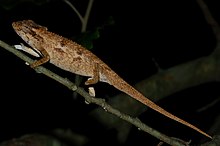
The Kentani dwarf chameleon (Bradypodion kentanicum) occurs in coastal area of the Eastern Cape, South Africa. (Full article...) -
Image 6
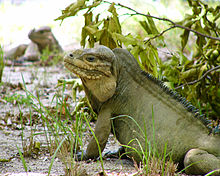
The Mona ground iguana (Cyclura stejnegeri) is a critically endangered species of rock iguana, endemic to Mona Island, Puerto Rico. It is one of the island nation's few large land animals, and it is the largest endemic terrestrial lizard in the country, and one of the biggest rock iguanas within the Antilles. It was previously considered a subspecies of the rhinoceros iguana (Cyclura cornuta). (Full article...) -
Image 7A desert iguana near Amboy Crater, California
The desert iguana (Dipsosaurus dorsalis) is an iguana species found in the Sonoran and Mojave Deserts of the Southwestern United States and northwestern Mexico, as well as on several Gulf of California islands. (Full article...) -
Image 8
The hybrid iguana is a first-generation hybrid, the result of intergeneric breeding between a male marine iguana (Amblyrhynchus cristatus) and a female Galapagos land iguana (Conolophus subcristatus) on South Plaza Island in the Galápagos Islands, where the territories of the two species overlap. (Full article...) -
Image 9
The Komodo dragon (Varanus komodoensis), also known as the Komodo monitor, is a large reptile of the monitor lizard family Varanidae that is endemic to the Indonesian islands of Komodo, Rinca, Flores, Gili Dasami, and Gili Motang. It is the largest extant species of lizard, with the males growing to a maximum length of 3 m (10 ft) and weighing up to 150 kg (330 lb). (Full article...) -
Image 10

The Galápagos land iguana (Conolophus subcristatus) is a very large species of lizard in the family Iguanidae, and one of three species of the genus Conolophus. It is endemic to the Galápagos Islands off of Ecuador's Pacific coast, inhabiting the dry lowlands of Fernandina, Isabela, Santa Cruz, North Seymour, Baltra, and South Plaza islands. (Full article...) -
Image 11
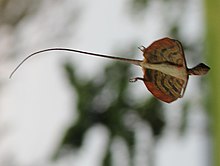
Draco taeniopterus, the Thai flying dragon, barred flying dragon, or barred gliding lizard, is a species of agamid lizard. It is found in Myanmar, Thailand, Cambodia, and Malaysia. (Full article...) -
Image 12An adult green iguana in Costa Rica
The green iguana (Iguana iguana), also known as the American iguana or the common green iguana, is a large, arboreal, mostly herbivorous species of lizard of the genus Iguana. Usually, this animal is simply called the iguana. The green iguana ranges over a large geographic area; it is native from southern Brazil and Paraguay as far north as Mexico. (Full article...) -
Image 13
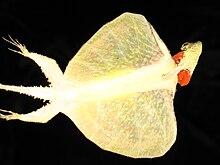
Draco norvillii, also known as Norvill's flying lizard, is species of agamid flying lizard endemic to India. This species is capable of gliding from tree to tree, and has been recorded gliding up to 50 metres (160 ft). It feeds on insects and other small invertebrates. (Full article...) -
Image 14Rock Iguana may refer to: (Full article...)
-
Image 15Orange iguana may refer to (Full article...)
-
Image 16White-throated monitor at Kruger National Park, South Africa
The rock monitor (Varanus albigularis) is a species of monitor lizard in the family Varanidae. The species is endemic to Sub-Saharan Africa, where, on average it is the largest lizard found on the continent. It is called leguaan or likkewaan in some areas. (Full article...) -
Image 17
Draco volans, also commonly known as the common flying dragon, is a species of lizard in the family Agamidae. The species is endemic to Southeast Asia. Like other members of genus Draco, this species has the ability to glide using winglike lateral extensions of skin called patagia. (Full article...) -
Image 18
Rhacodactylus is a genus of medium to large geckos of the family Diplodactylidae. All species in this genus are found on the islands that make up New Caledonia. (Full article...) -
Image 19

The tropical house gecko (Hemidactylus mabouia), also called commonly the Afro-American house gecko and the cosmopolitan house gecko, is a species of house gecko, a lizard in the family Gekkonidae. The species is native to sub-Saharan Africa. However, it is also found in North, Central and South America and the Caribbean, where it has been inadvertently introduced by humans. (Full article...) -
Image 20
The desert monitor (Varanus griseus) is a species of monitor lizard of the order Squamata found living throughout North Africa and Central and South Asia. The desert monitor is carnivorous, feeding on a wide range of vertebrates and invertebrates. (Full article...) -
Image 21Draco indochinensis on a tree in Tân Phú district, Đồng Nai, Vietnam
Draco indochinensis, also known as the Indochinese flying lizard or Indochinese gliding lizard, is a species of agamid lizard endemic to South-east Asia (Cambodia and southern Vietnam). (Full article...) -
Image 22

The northern Bahamian rock iguana (Cyclura cychlura) is a species of lizard of the genus Cyclura that is found on Andros Island and the Exuma islands in the Bahamas. Its status on the IUCN Red List is vulnerable, with a wild population of less than 5,000 animals. (Full article...) -
Image 23

The Alfa Romeo Iguana is a concept car produced by Alfa Romeo in 1969. It was designed by Giorgetto Giugiaro at Italdesign. (Full article...) -
Image 24The Ngome dwarf chameleon (Bradypodion ngomeense) is a species of chameleon found in South Africa. (Full article...)
-
Image 25
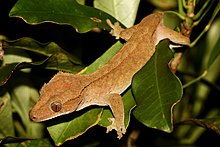
The crested gecko (Correlophus ciliatus), also known commonly as the eyelash gecko, is a species of lizard in the family Diplodactylidae. The species is native to southern New Caledonia. In 1866, the crested gecko was originally described by French zoologist Alphonse Guichenot. The species was thought to be extinct until it was rediscovered in 1994 during an expedition led by German herpetologist Robert Seipp. Along with several other New Caledonian gecko species, it is being considered for protected status by the Convention on the International Trade in Endangered Species of Wild Flora and Fauna. (Full article...)
Selected turtle articles
-
Image 1

The Big-headed Amazon River turtle (Peltocephalus dumerilianus), also known as the big-headed sideneck, is a species of turtle in the family Podocnemididae. (Full article...) -
Image 2
Pan's box turtle (Cuora pani) is a species of turtle in the family Geoemydidae (formerly Bataguridae). The yellow-headed box turtle is sometimes included herein as a subspecies (Cuora pani aurocapitata). (Full article...) -
Image 3The tricarinate hill turtle or three-keeled land turtle (Melanochelys tricarinata) is a species of turtle found in northeastern India, Bangladesh, and Nepal. (Full article...)
-
Image 4
The Asian narrow-headed softshell turtle (Chitra chitra) is a large species of softshell turtle in the family Trionychidae. The species is endemic to Southeast Asia. (Full article...) -
Image 5
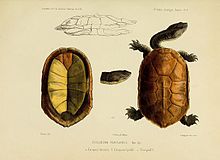
The Brazilian snake-necked turtle (Hydromedusa maximiliani ), locally known as cágado da serra, and also commonly known as Maximilian's snake-necked turtle, is a species of turtle in the family Chelidae. The species is endemic to southeastern Brazil. It is one of the smallest Brazilian freshwater turtles reaching a maximum straight carapace length of 20 cm (7.9 in). The species prefers streams with sandy and rocky bottoms and clear water in forests above 600 m (2,000 ft) elevation. (Full article...) -
Image 6

The Gulf Coast spiny softshell turtle (Apalone spinifera aspera), a subspecies in the Trionychidae family of softshell turtles, is endemic to the south-eastern United States. (Full article...) -
Image 7The northern spotted box turtle (Terrapene nelsoni klauberi), also commonly known as Klauber's box turtle and Klauber's spotted box turtle, is a subspecies of turtle in the family Emydidae. (Full article...)
-
Image 8The Jalisco mud turtle (Kinosternon chimalhuaca) is a species of mud turtle in the Kinosternidae family endemic to Mexico. It is found in Colima and Jalisco. They live in freshwater habitats like swamps or quiet rivers. Jalisco mud turtles reproduce oviparous, meaning the eggs hatch after the parent has laid them.
Population size is unknown; there have been less than 20 individuals seen in the last twenty years. The mud turtle is said to be adapted to aquatic habitats, meaning that a population decline is then expected due to habitat fragmentation. (Full article...) -
Image 9Black-bridged leaf turtle may refer to: (Full article...)
-
Image 10Red turtle may refer to: (Full article...)
-
Image 11
The Japanese pond turtle (Mauremys japonica), also called commonly the Japanese pond terrapin and the Japanese pond tortoise, is a species of turtle in the family Geoemydidae endemic to Japan. Its Japanese name is nihon ishigame, Japanese stone turtle. Its population has decreased somewhat due to habitat loss, but it is not yet considered a threatened species. (Full article...) -
Image 12

Bourret's box turtle (Cuora bourreti), also known commonly as the central Vietnamese flowerback box turtle and the Indochinese box turtle, is a species of turtle in the family Geoemydidae. The species is endemic to Southeast Asia. (Full article...) -
Image 13

The Mekong snail-eating turtle (Malayemys subtrijuga) is a species of turtle in the family Geoemydidae. It was monotypic within the genus Malayemys until Brophy (2004, 2005) reevaluated (based on morphology) Malayemys macrocephala (Gray, 1859), which has been long time considered to be a synonym of M. subtrijuga. (Full article...) -
Image 14The Burmese narrow-headed softshell turtle (Chitra vandijki), also known commonly as the Myanmar narrow-headed softshell turtle and Van Dijk's chitra, is a species of turtle in the family Trionychidae. The species is endemic to Southeast Asia. (Full article...)
-
Image 15

The Yucatán box turtle (Terrapene yucatana) is a species of box turtle endemic to Mexico. It is sometimes treated as a subspecies of Terrapene carolina. (Full article...) -
Image 16
Creaser's mud turtle (Kinosternon creaseri) is a species of mud turtle in the family Kinosternidae. The species is endemic to the Yucatán Peninsula in southeastern Mexico. (Full article...) -
Image 17
The Roti Island snake-necked turtle (Chelodina mccordi), also commonly known as McCord's snakeneck turtle, is a critically endangered turtle species. It is named after Rote Island in Indonesia where it was first discovered. Some individuals were later discovered in East Timor, and are considered a distinct subspecies. (Full article...) -
Image 18
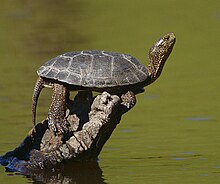
The western pond turtle (Actinemys marmorata), also known commonly as the Pacific pond turtle is a species of small to medium-sized turtle in the family Emydidae. The species is endemic to the western coast of the United States and Mexico, ranging from western Washington state to northern Baja California. It was formerly found in Canada (in British Columbia), but in May 2002, the Canadian Species at Risk Act listed the Pacific pond turtle as being extirpated. (Full article...) -
Image 19From Medellin, Colombia
The Magdalena River turtle or Rio Magdalena river turtle (Podocnemis lewyana) is a species of turtle in the family Podocnemididae, which diverged from other turtles in the Cretaceous Period, 100 million years ago. It is endemic to northern Colombia, where its home range consists of the Sinú, San Jorge, Cauca, and Magdalena river basins. (Full article...) -
Image 20

The Assam leaf turtle (Cyclemys gemeli) is a species of turtle in the family Geoemydidae. The species is native to India, Nepal, Bhutan, and Bangladesh. (Full article...) -
Image 21Black mud turtle may refer to: (Full article...)
-
Image 22
The eastern black-bridged leaf turtle (Cyclemys pulchristiata) is a species of Asian leaf turtles found in southern Indochina. (Full article...) -
Image 23
The keeled box turtle (Cuora mouhotii; syn. Pyxidea mouhotii) is a species of turtle in the family Geoemydidae. The species is endemic to Asia. (Full article...) -
Image 24
The leatherback sea turtle (Dermochelys coriacea), sometimes called the lute turtle, leathery turtle or simply the luth, is the largest of all living turtles and the heaviest non-crocodilian reptile, reaching lengths of up to 2.7 metres (8 ft 10 in) and weights of 500 kilograms (1,100 lb). It is the only living species in the genus Dermochelys and family Dermochelyidae. It can easily be differentiated from other modern sea turtles by its lack of a bony shell; instead, its carapace is covered by oily flesh and flexible, leather-like skin, for which it is named. Leatherback turtles have a global range, although there are multiple distinct subpopulations. The species as a whole is considered vulnerable, and some of its subpopulations are critically endangered. (Full article...) -
Image 25

The brown roofed turtle (Pangshura smithii) is a species of turtle in the family Geoemydidae. The species is endemic to South Asia. Two subspecies are recognized. (Full article...)
Need help?
Do you have a question about Reptiles that you can't find the answer to?
Consider asking it at the Wikipedia reference desk.
Topics
Major extant reptile clades | |||||
|---|---|---|---|---|---|
| Lepidosauria | |||||
| Archelosauria |
| ||||
Related portals
Associated Wikimedia
The following Wikimedia Foundation sister projects provide more on this subject:
-
Commons
Free media repository -
Wikibooks
Free textbooks and manuals -
Wikidata
Free knowledge base -
Wikinews
Free-content news -
Wikiquote
Collection of quotations -
Wikisource
Free-content library -
Wikiversity
Free learning tools -
Wiktionary
Dictionary and thesaurus





